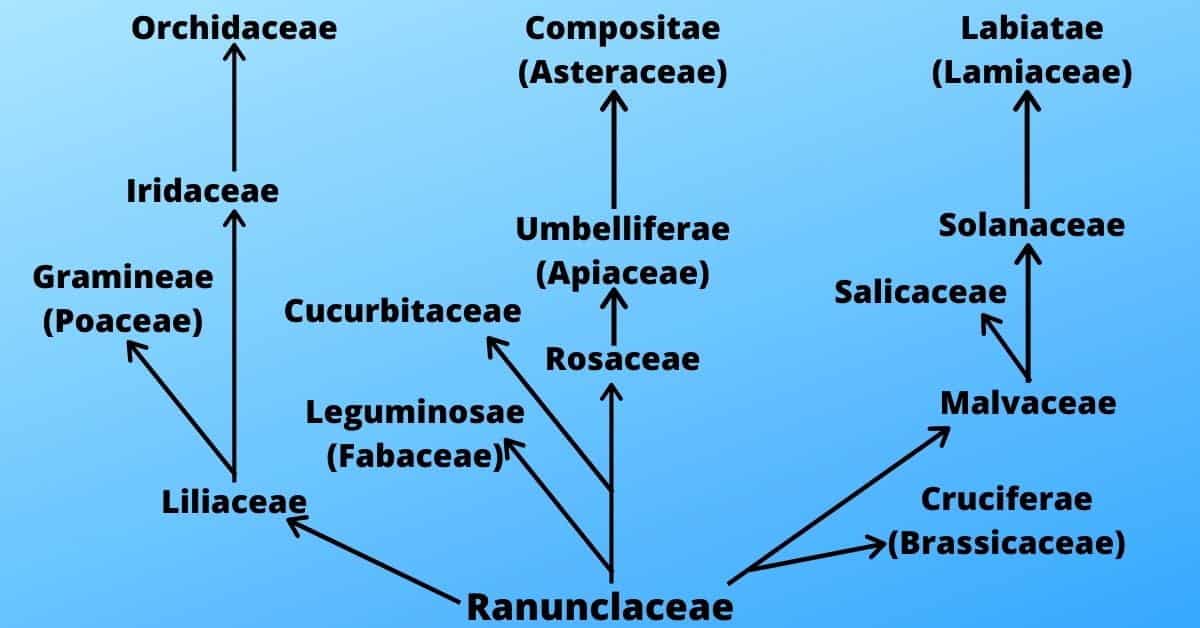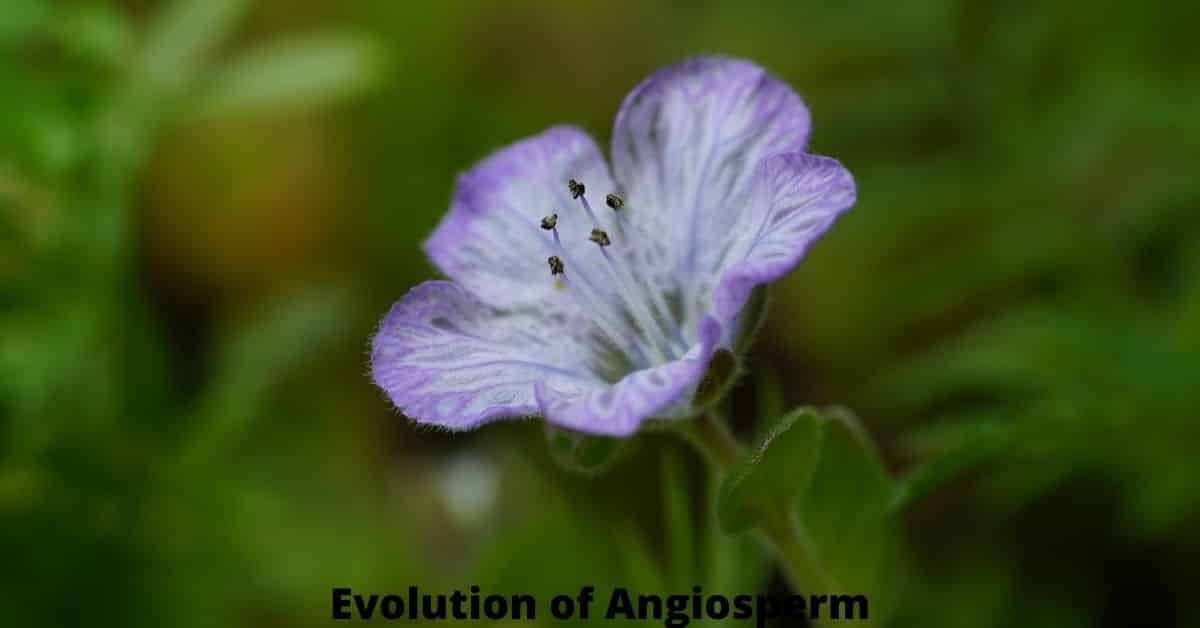The angiosperms are thought to represent the climax of an extensive evolution and it would appear that the evolution of angiosperm has been still a continuous process.
principal evolutionary tendencies of the flowers
The principal evolutionary tendencies of the flowers:
- Elongated floral axis to shortened floral axis.
- Spiral arrangements of floral parts to the whorled arrangement.
- Complete and perfect flowers to incomplete flowers.
- Regular flowers to irregular flowers.
- Hypogynous to epigynous flowers.
- Many free stamens and carpels to few United stamens and carpels.
The family Rannunculaceae of Ranales is thought to be the most primitive type from which the other angiosperm families have evolved in different lines. The Ranunculaceae is thought to be the most primitive type for the following characteristics:
- The floral parts i.e. calyx, Corolla, stamens and carpels, are numerous and arranged in close spirals on the receptacle.
- In most cases the floral parts are not at all fused together.
From the Ranalian type of flower, the evolution is thought to precede in at least 3 mainline is based –

3 lines in evolution of angiosperm
- First line – This line culminates in Labiatae ( Lamiaceae) through Malvaceae and Solanaceae with Cruciferae ( Brassicaceae) and Salicaceae as side branches.
- Second line – This line culminates in Compositae( Asteraceae) through Rosaceae and Umbelliferae ( Apiaceae) with Leguminosae (Fabaceae) and Cucurbitaceae as side branches.
- Third line – This line culminates in Orchidaceae through Liliaceae and Iridaceae with Gramineae ( Poaceae) as a side branch developed from Liliaceae.
First Line
In this line evolution of angiosperm proceeds from Ranunculaceae to Labiatae. This evolutionary line is based on:
- Hypogynous condition of flowers is constant.
- Presence of syncarpous ovaries, as well as the number of floral parts, are the phenomena.
- Other types of union and the shift to irregular flowers have appeared somewhat later, but still early in this line.
The line was traced through different families based on these characteristics:
Malvaceae:
- This family has comparatively primitive characteristics like actinomorphic, complete and perfect flowers.
- Stamens multiple and monadelphous, carpels 5 to more and syncarpous.
- Leaves simple with the free lateral type of stipule.
Cruciferae ( Brassicaceae):
- The numbers show the reduction in the number of floral parts and only the carpels are United.
- Simple leaves and bisexual, actinomorphic flowers.
Solanaceae:
- Flowers are regular and perfect which show a union of sepals, petals and carpels.
- Calyx persistence on fruit.
- Stamens epipetalous.
- Syncarpous type of carpels.
Salicaceae:
It is a comparatively advanced family and shows the following characteristics:
- Reduction in both size and number of floral parts.
- Calyx, Corolla is absent and the flowers are arranged in catkins.
- Flowers are unisexual.
- Mae flower: the number of stamens ha been reduced to 1 – 2.
- Female flower: Hypogynous condition is still continuing.
- Pollination takes place by wind rather than insects.
Besides on the above, the Salicaceae is considered as a side branch much advanced than Malvaceae. Finally, the Labiatae is considered as the endpoint in this line based on the following characteristics:
- Flowers are irregular but remain hypogynous.
- Flowers show union in sepals, petals and carpels.
- Epipetalous condition of stamens.
- Flowers are specially adapted for insect pollination.
Second Line
In this line, evolution of angiosperm proceeds from Ranunculaceae to Compositae ( Asteraceae). Hypogyny to epigyny is noticed during the early part of evolution. The mainline is divided into two branches. One branch shows actinomorphic without coalescence and the other one shows zygomorphy with coalescence.
Rosaceae:
A primitive family in this line shows much variation in floral structure. These are –
- Members of the comparatively primitive group show regular, perfect and slightly perigynous flowers with numerous parts.
- Flowers are usually bisexual, regular and pentamerous.
- Other members show gradual coalescence, reduction in the number of floral parts and also from slightly perigynous condition to typical perigynous condition.
- Stamens are numerous.
- Petals 5 Or more.
sidelines are considered to be developed from the nearby region of Rosaceae. These are Leguminosae (Fabaceae) and Cucurbitaceae. This consideration is based on the following characteristics of the two families:
Leguminosae:
- Reduction in the number of floral parts.
- Bisexual flowers.
- Union of some petals and Corolla parts thus became irregular.
- Union of stamens.
- Gynoecium with solitary carpel is commonly hypogynous, but perigyny is also visible.
- Placentation marginal.
Cucurbitaceae:
- Flowers imperfect, unisexual and actinomorphic.
- Epigyny in female flowers.
- Union of different floral parts.
- Stamens are generally synandrous ( both anthers and filaments are united).
- Ovary inferior.
The line of evolution to be progressed further from Rosaceae to Umbelliferae is based on the following characteristics:
Umbelliferae:
- Flowers epigynous.
- Union of carpels i.e. syncarpy.
- Umbel inflorescence.
- Ovary inferior and free stylopodium.
- Fruit schizocarp ( consists of two mericarps).
Finally, The Compositae (Asteraceae) is considered as the culminating point for the following characteristics:
Compositae:
- Reduction in the number of floral parts.
- Flowers imperfect.
- Modification of calyx into Pappus in most cases.
- Union of each whorl and adnation.
- Capitulum inflorescence.
- Stamens syngenesious ( anthers always united in a tube).
- Placentation basal type.
- Cypsela type of fruit.
Third line
In this line, evolution of angiosperm proceeds from Ranunculaceae to Orchidaceae. The primitive monocotyledonous, like the members of Alismataceae, are very much common with Ranunculaceae. The line of evolution to be progressed further to Liliaceae is based on the following characteristics:
Liliaceae:
- Reduction in the number of floral parts.
- Union of carpels.
- Anthers basifixed, extrorse or introrse.
- Syncarpous ovary.
The line of evolution that progressed further to Iridaceae is based on the following characteristics:
Iridaceae:
- Flowers show epigyny.
- Leaves are generally grass-like, having a sharp central fold.
Finally, the Orchidaceae is considered as the culminating point for the following characteristics:
Orchidaceae:
- Flowers are irregular.
- Flowers are showy and highly specialised for insect pollination.
- Labellum present.
- Pollen grains are present in pollinia.
- The filament is united with the style and forms a column, the gynandrium.
- Out of 3 stigmas, 2 are fertile and other 1 is sterile forming rostellum.
- Fruits are without endosperm.
The family Graminae that evolved from Liliaceae as a sideline is based on the following characteristics:
Gramineae:
- Loss of perianth members.
- Spikelet inflorescence.
- Phyllotaxy is an alternate and distichous type.
- Reduction in the number of stamens and carpels.
- Versatile type of anther.
- Stigma feathery.
- Fruit caryopsis type.
If you have any query regarding “Evolution of Angiosperm” post, then don’t hesitate to comment below.

